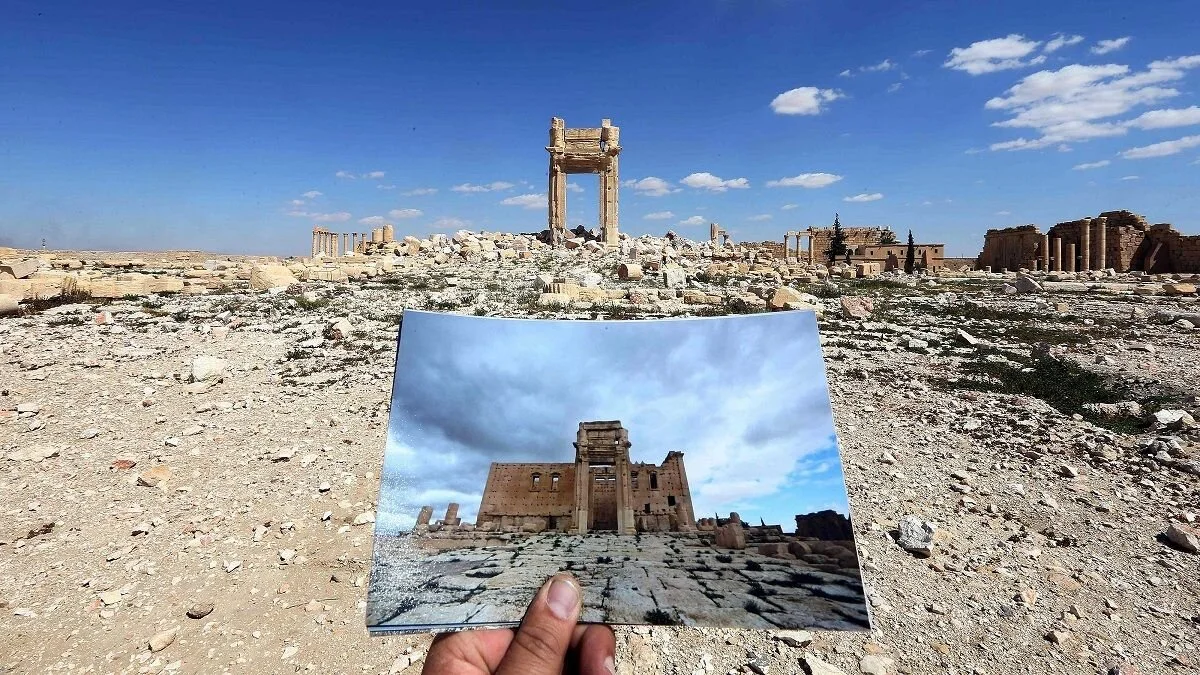7 Cultural Sites Damaged or Destroyed by War
Violence in Europe, the Middle East and West Africa has taken a toll on historic buildings and monuments.
1. Vijećnica (City Hall) of Sarajevo, Bosnia
The historic City Hall, or Vijećnica, of Sarajevo dates to the 1890s. Its architecture was inspired by Islamic designs; specifically, the Mamluk architecture that flourished between the 13th and 16th centuries in Cairo, Egypt. In 1949, the city converted it into the National Library.
In 1992, the Vijećnica went up in flames during the Siege of Sarajevo, destroying almost two million books. The city worked to restore the Vijećnica, and in 2014, it reopened it to the public.
A 1992 photograph shows Cellist Vedran Smailovic playing Strauss in the bombed National Library in Sarajevo.
Michael Evstafiev/AFP/Getty Images
The historic City Hall, or Vijećnica, of Sarajevo dates to the 1890s. Its architecture was inspired by Islamic designs; specifically, the Mamluk architecture that flourished between the 13th and 16th centuries in Cairo, Egypt. In 1949, the city converted it into the National Library.
In 1992, the Vijećnica went up in flames during the Siege of Sarajevo, destroying almost two million books. The city worked to restore the Vijećnica, and in 2014, it reopened it to the public.
Related video: Bosnia's cultural symbol reopens in Sarajevo
2. Buddhas of Bamiyan, Afghanistan
The Buddhas of Bamiyan were once the tallest monuments of Buddha in the world. Carved into the side of a cliff in the sixth century, the largest one was over 170 high. The Buddhas soon became known as a holy site. In 629 A.D., the Chinese traveller Xuanzang described tens of thousands of monks gathered near the statues.
But in 2001, the Taliban destroyed the Buddhas by bombing them over several weeks. The destruction followed a command by spiritual leader Mullah Mohammed Omar ordering the destruction of idolatrous statues in Afghanistan.
Related video:
3. Djinguereber Mosque of Timbuktu, Mali
An undated photograph of Djinguereber Mosque in Timbuktu
The Mali Empire built the Djinguereber Mosque in Timbuktu during the reign of Mansa Musa in the 14th century. It is made out of pounded earth and wood, and is still an important part of city life today.
However, the mosque suffered minor damage in 2012 when members of the militant Ansar Dine group attacked the city. The group damaged two of Djinguereber’s tombs along with Islamic shrines in the city that the Ansar Dine deemed sacreligious. In 2016, Ahmad al-Faqi al-Mahdi pleaded guilty to damaging these sites in the International Criminal Court, marking the court’s first prosecution of the destruction of cultural sites as a war crime.
4. Great Mosque of Aleppo, Syria
The Great Mosque of Aleppo was built between the eighth and 13th centuries. Traditionally, it’s believed to contain the remains of the prophet Zechariah, father of John the Baptist. It was one of the largest and oldest mosques in Aleppo, located within the wall of the Old City.
The Great Mosque’s minaret, a tall tower from which a crier calls Muslims to daily prayer, was built in the 11th century. But in 2013, it was destroyed amid fighting in the Syrian Civil War. It remains unclear what caused the collapse of the tower. The mosque was occupied at the time by anti-government forces, and Syrian President Bashar al-Assad's regime blamed the damage on fighters from an al-Qaeda-linked group. Rebels, meanwhile, claimed the site was damaged by incoming Syrian Army fire.
5. Temple of Bel at Palmyra, Syria
Foto: Joseph Eid/AFP/TT
The Temple of Bel was a major religious site in the ancient city of Palmyra. Built in the first century, the temple was consecrated to the Mesopotamian god Bel (or Baal). The site contained more than 1,000 columns, over 500 tombs and a Roman aqueduct.
In 2015, the so-called Islamic State of Iraq and Syria, or ISIS, leveled the nearly 2,000-year-old temple. The attack followed the destruction of the Temple of Baalshamin, another ancient religious site in Palmyra.
6. The Gates of Nineveh, Iraq
The ancient Assyrian city of Nineveh dates to the seventh century B.C. The city was historically guarded by walls and multiple gates. Two of the most prominent gates were the Adad Gate and the Mashki Gate, also known as the “Gate of God.”
In 2016, ISIS destroyed both of these gates as part of its ongoing campaign against cultural sites and relics.
ISIS destroys Temple of Nabu at Nimrud, Nergal Gate at Nineveh
7. The Parthenon, Athens, Greece
The Parthenon was extensively damaged in 1687, during the Great Turkish War (1683–1699). The Ottoman Turks fortified the Acropolis of Athens and used the Parthenon as a gunpowder magazine and a shelter for members of the local Turkish community. On 26 September a Venetian mortar round blew up the magazine, and the explosion blew out the building's central portion. About three hundred people were killed in the explosion, which caused fires that burned until the following day and consumed many homes. Parthenon was extensively and permanently damaged when Thomas Bruce, the 7th Earl of Elgin and ambassador to the Ottoman Empire (occupiers of Greece in the early 19th century), who admired the Parthenon's extensive collection of ancient marble sculptures, began extracting and expatriating them to Britain in 1801. The latter damage is still considered one of the most significant destructions of heritage in the history of the Parthenon.
Related video: The Parthenon through time


















